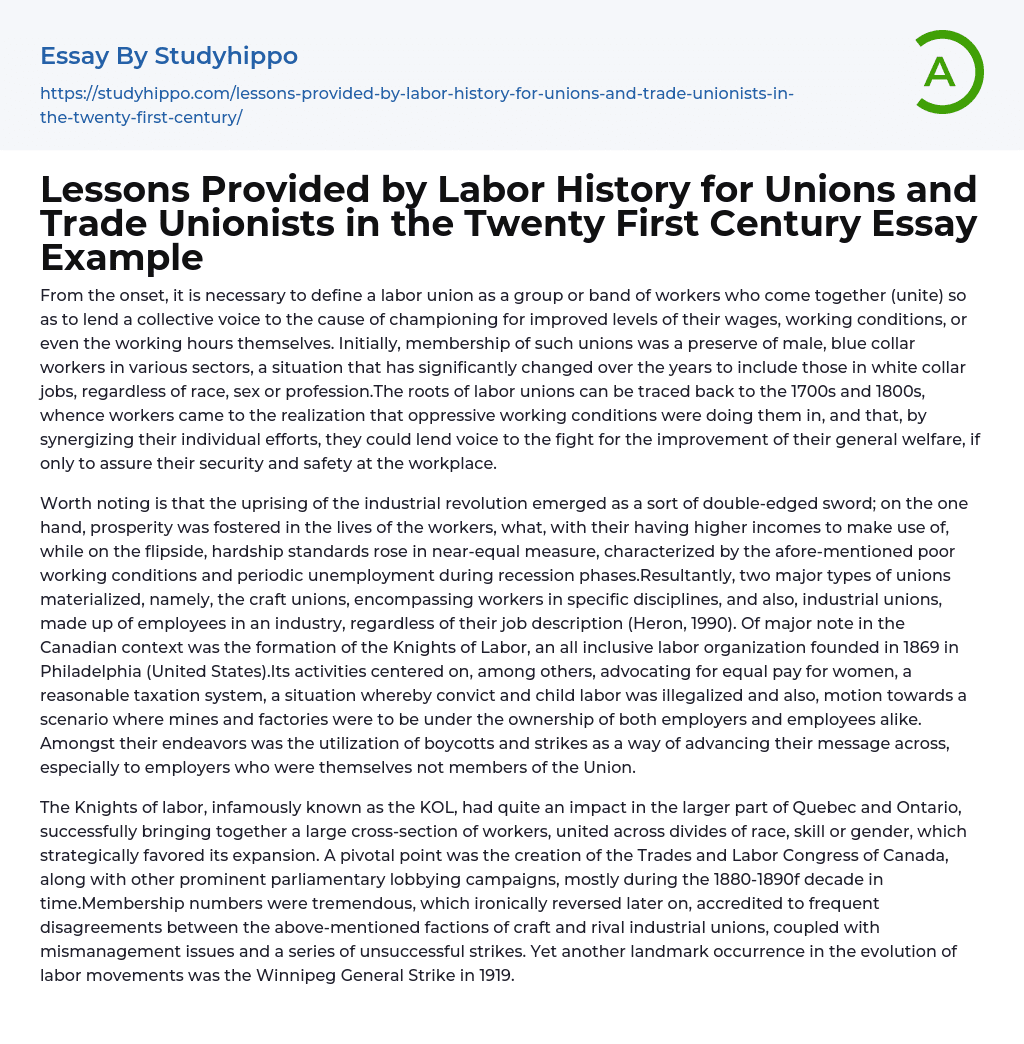Labor unions are groups of workers who unite to demand improvements in pay, working conditions, and hours. Originally composed mainly of male blue-collar employees from various sectors, these organizations have expanded over time to include white-collar professionals of any gender or race. These associations date back to the 1700s and 1800s when laborers recognized that hazardous work environments were negatively affecting their lives. By banding together through collective action, they could amplify their individual efforts and push for better safety measures and job security.
It is noteworthy that the industrial revolution had both positive and negative effects. Although the workers enjoyed higher incomes, they also faced poor working conditions and periodic unemployment during recessions. This led to the formation of two types of unions: craft unions for workers in specific disciplines and industrial unions for emplo
...yees in an entire industry regardless of their job description. The Knights of Labor was a significant labor organization in Canada, founded in 1869 in Philadelphia. Their objectives included advocating for equal pay for women, fair taxation, illegalization of convict and child labor, and a scenario where mines and factories were to be owned by both employers and employees. The union utilized boycotts and strikes to advance their message, especially to non-unionized employers.
The KOL, or Knights of Labor, had a major influence in Quebec and Ontario, as they brought together workers from different backgrounds, including race, skill, and gender. This helped the group expand strategically. One notable accomplishment was the creation of the Trades and Labor Congress of Canada, which resulted from effective parliamentary lobbying campaigns during the 1880s and 1890s. Membership numbers were high, but disputes between craft an
rival industrial unions, as well as mismanagement and failed strikes, caused a decline in numbers. The Winnipeg General Strike of 1919 was another significant milestone in the history of labor movements.
The text discusses the importance of a strike that occurred in Canada, which laid the groundwork for future labor movements. The strike was carried out by representatives from the country's western region and resulted in the adoption of striking measures to address future conflicts. Although initially dismissed from their jobs, the striking workers were eventually reinstated with higher pay following their successful efforts. The Conservative government played down the impact of the strike, resulting in their defeat during the 1921 election and prompting an inquiry into desired labor reforms under Liberal leadership. Overall, this example underscores how labor history has significantly influenced modern society through its impact on labor practices and reforms (Heron, 1990).
Labor unions have played a significant role in politics, influencing the formation of political parties such as the British Labor Party and the Democratic party in the United States. Politicians seeking support from labor organizations often prioritize addressing labor issues during election cycles. Despite employers' efforts to thwart unionization through anti-union publicity campaigns, relocation measures, and employee schemes aimed at substituting labor organizations, trade unionists have learned from history and remain aware of these tactics.
The use of the "shelf-life" effect is a common tactic employed by management authorities to encourage employee participation in the workplace, particularly during times of labor shortages and high turnover rates. However, this approach is often abandoned once its immediate purpose has been served (Heron, 1990). Throughout history, employers have employed various strategies with different messages, including
employee participation and scientific management, in order to improve their public image. Additionally, employers frequently engage in "organizational amnesia," re-packaging failed policies and regulations in an attempt to improve workplace efficiency.
This makes it pointless to try and fix issues or improve things within a sector. Similarly, union leaders may fall victim to this by ignoring past innovations to solve current concerns. Therefore, studying history helps gain knowledge on why certain measures succeeded or failed in the past and how they can be applied today (Victoria, 1993). In addition, examining history allows trade unionists to understand the limitations of unions in terms of size, geography, and economic conditions within a country.
A significant hindrance to successful labor union operations is the existence of internal conflicts, which undermine collective efforts. The lack of effectiveness in advocating for causes may also be attributed to competitive unionism, where different trade unions battle for more members instead of working towards a common goal. History plays a crucial role in understanding labor processes and formulating union strategies. Labor historians provide insights into the tactics employers use to frustrate trade and labor body initiatives. It is important to note that the principles and values upheld by trade unions determine their destiny.
- Russian Empire essays
- Ancient Greece essays
- British Empire essays
- Historical Figures essays
- Nazi Germany essays
- Roman Empire essays
- War essays
- Revolution essays
- 19Th Century essays
- Historiography essays
- History of the United States essays
- 20Th Century essays
- World History essays
- Vikings essays
- Declaration of Independence essays
- Civilization essays
- Evidence essays
- Genocide essays
- Colonialism essays
- Rebellion essays
- 1960S essays
- 1920S essays
- 1950S essays
- Letter from Birmingham Jail essays
- Louisiana Purchase essays
- The Columbian Exchange essays
- World Hunger essays
- What is History essays
- Bravery essays
- Gilded Age essays
- Vladimir Lenin essays
- Alexander The Great essays
- Sparta essays
- Victorian Era essays
- Henry v essays
- Stonehenge essays
- Frederick Douglass essays
- Mahatma Gandhi essays
- Joseph Stalin essays
- Geert Hofstede essays
- George Eliot essays
- Ginevra King essays
- John Keats essays
- Siegfried Sassoon essays
- Ben jonson essays
- Billy elliot essays
- Wilkie collins essays
- John Proctor essays
- Harriet Tubman essays
- Napoleon essays




